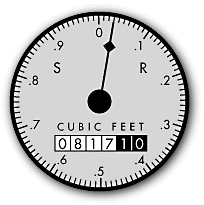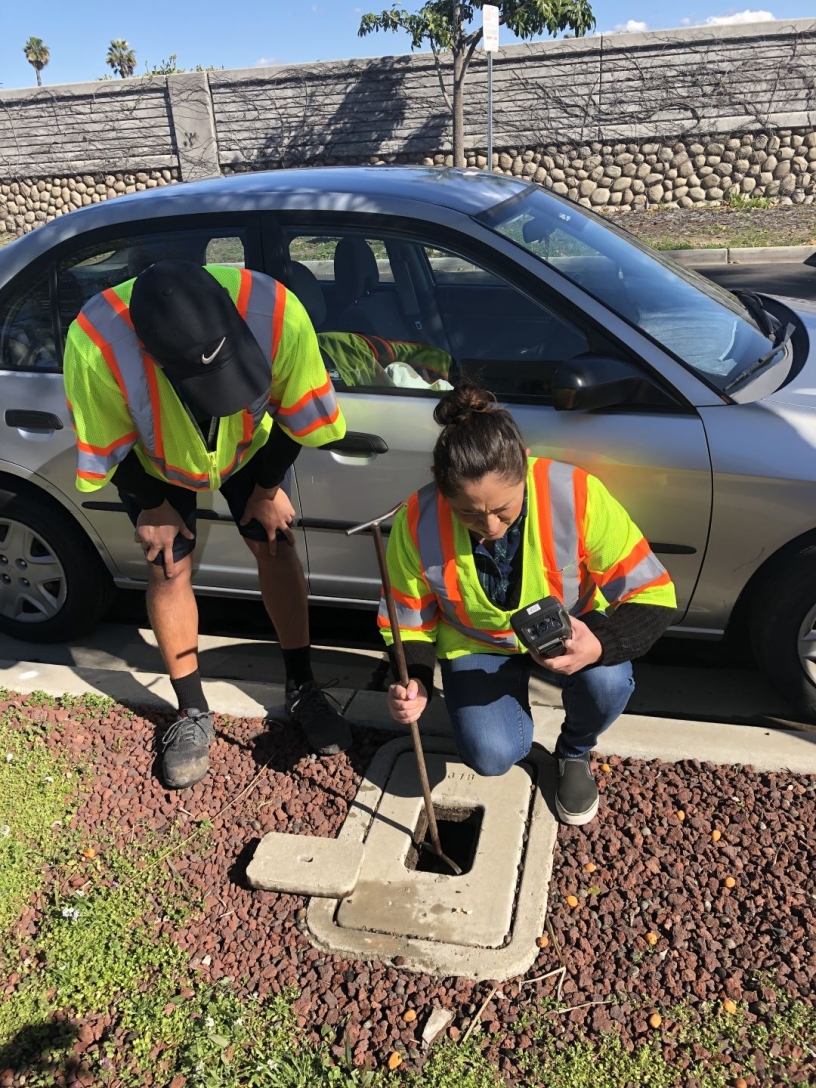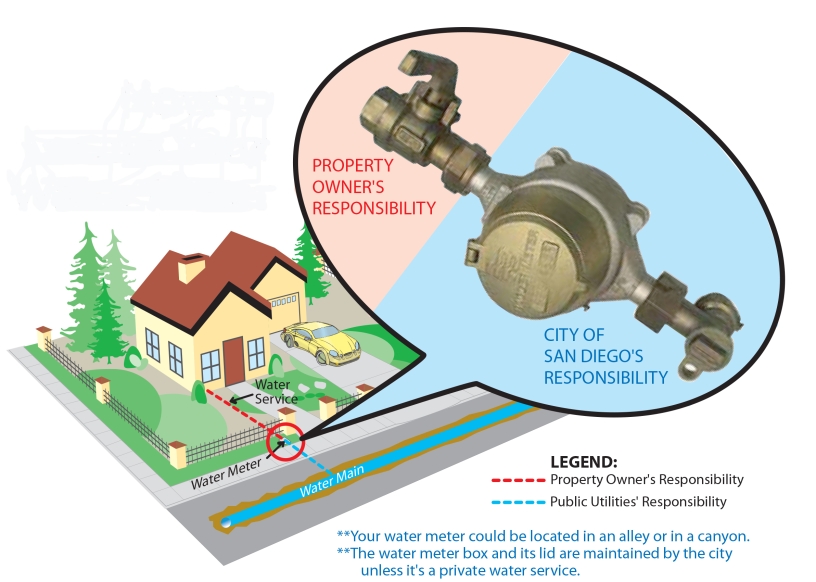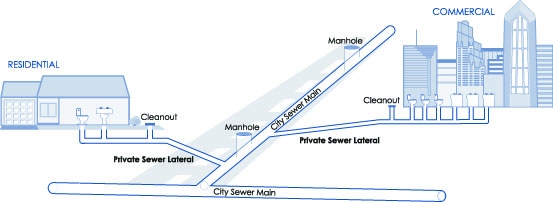Your Meter, Water Pressure & Plumbing System
How to Read Your Water Meter
All customers within the City of San Diego have their water use measured by a meter. This results in each customer paying their share of operating the system based on the amount of water used.
All City of San Diego meters measure water in cubic feet (one cubic foot equals about 7.5 gallons). Charges for the amount of water consumed are based on the number of units of 100 cubic feet (748.5 gallons) you use during a billing period. You will see this listed on your bill as HCF.
There are several reasons you may want to be able to locate and read your water meter.
- First, you might be interested in just how much water you use daily. By reading your meter at the beginning and the end of the day, you can compare the two totals to determine how much water you and your family used.
- Second, you might want to see if the meter read listed on your bill is accurate.
- Third, you might want to check for leaks. Turn all faucets and water-using appliances off and look at your meter. If it is still turning, chances are you have a leak somewhere.
Here is some useful information about your water meter:
Step 1
Locate Your Meter
Your water meter is usually located near the curb in front of your home or place of business in a direct line with the main outside faucet. It is housed in a concrete box usually marked "water." More details about finding your water meter.
Carefully remove the lid by using a tool such as a large screwdriver. Please do not use your fingers. Insert the tool into one of the holes and pry the lid off. Visually examine the area around the meter to ensure there are no harmful insects or other animals. Small animals and rodents often dig around meters and disturb the soil, so you may need to dust off the meter to get a read. Gloves and or a small trowel can be helpful.
Step 2
Read Your Water Meter

Over the years, the City has used several different brands and models of water meters. To find information on your particular water meter, please consult the ![]() Water Meter Visual Glossary.
Water Meter Visual Glossary.
In the picture of the water meter register shown, note the figures under the words CUBIC FEET. In this example, the meter shows 81,710. Because charges are based on units of 100 cubic feet, we ignore the last two numbers (the ones in the black background). So, the reading, in this case, is 817.
Estimating a Read
Meters cannot be read from time to time due to meter access impediments, staffing resources or a malfunctioning meter that registers zero use. In cases such as these, an estimated read will be provided based on prior use. The read shall be estimated using the daily usage for the same period the previous year or the average daily usage for the year if there is no billing history for that period.
If you have questions about your current meter read, please visit the Report a Meter Misread page.
Questions About Your Meter Read
 While the Public Utilities Department has a high meter reading accuracy rate, errors can occur.
While the Public Utilities Department has a high meter reading accuracy rate, errors can occur.
If you believe your water meter was misread and can safely read your water meter, please follow the directions below:
- Review the instructions on how to read your meter.
- Compare the read that is displaying on your water meter now to the read indicated on your last water/wastewater utility bill. If the meter read printed on your bill is higher than the read that is currently displayed on your meter, take a photo of the current read on your water meter and submit it here.
If you believe your water meter was misread and cannot safely read your water meter, please follow the directions below:
- Visit this webpage and provide the account number, the account holder’s name and the service address of the meter. Once we receive this information, a team member will schedule a Field Representative to visit your property to obtain the current meter read and leave a doorhanger notification with their findings. Please note that you need not be present for this to occur. A team member will reach out to you to discuss the findings of the investigation. If your meter read is correct, a team member will provide information on the next steps to survey your property for possible leaks. If the meter read is incorrect, a team member will work with you to ensure the billing is corrected.
For all other billing-related questions, please call 619-515-3500.
Your Water Pressure
Water pressure varies in different parts of the City depending on location and demand. According to the California Plumbing Code, you are required to have a water pressure regulator on your property if the pressure in your area is more than 80 pounds per square inch (psi). Regulators are the responsibility of the property owner.
If you experience a water pressure problem, you can request the water pressure in your area be checked by calling 619-515-3525. A City Public Utilities crew member will test the water pressure at the nearest fire hydrant to your home, and the findings will be reported back to you. Water pressure normally fluctuates +/- 10 psi. If the water pressure in your neighborhood is found to be normal, then the water pressure problem is most likely due to a problem with the plumbing system on your property.
Fire sprinkler contractors can request fire hydrant water pressure and hydrant flow by completing Form DS-160 and following the instructions.
High Water Pressure
The most common cause of a sudden increase in water pressure is a faulty regulator on your property. The regulator may need to be adjusted or replaced. You may want to contact a plumbing professional to assess your water pressure regulator.
Low Water Pressure
There are several possibilities for a decrease in water pressure.
- Your water regulator may have failed in the closed position, reducing the water flow, and may need to be inspected by a plumber.
- If you live in an apartment or condominium or have a business that shares a water meter with others, your neighbors may have increased their water use resulting in an overall decrease in pressure.
- If water mains are being replaced in your neighborhood, there can be a decrease in water pressure while customers are connected to temporary water pipelines during construction.
- Leaks can also decrease water pressure.
Your Water Plumbing System
 The water system for a home or other property is connected to a City water main through a water lateral service line via a water meter. The property owner is responsible for the maintenance of any portion of the water system from the meter. This diagram shows the division between what is the City's responsibility and what is the responsibility of the property owner.
The water system for a home or other property is connected to a City water main through a water lateral service line via a water meter. The property owner is responsible for the maintenance of any portion of the water system from the meter. This diagram shows the division between what is the City's responsibility and what is the responsibility of the property owner.
- Checking for Water Leaks on Your Property.
- Water Meters
- Water Pressure - What to do if your water pressure is too high or too low.
- Water Hardness - Typically, drinking water in San Diego averages about 16 grains per gallon (gr/gal) or 276 parts per million (ppm), and depending upon water demand and the area of the City you live can range from 16 to 18 gr/gal or 272 to 284 ppm. More details are available in the annual Drinking Water Quality Reports.
- GIS Information (Maps and Records) - The City's Development Services Department has records showing when your water line was installed and can provide a map showing where your water line connects to the City's water main. You can schedule an appointment to review the records by calling 619-446-5300. However, the City does not have diagrams or other information regarding where water lines are located on your property. For that information, you may want to contact a licensed plumber.
- Water Construction and Development< - Information about permits and fees, design guidelines and standards, approved materials list and more.
- Cross-Connection Control and Backflow Prevention Programs.
Related Information
- Your Sewer Plumbing System.
- Service Line Warranties (preferred service line warranty partner of the City of San Diego).
- Water Quality.
Your Sewer Plumbing System
 The sewerage system for a home or property is connected to the City sewer main through a sewer lateral. The property owner is responsible for the maintenance of that lateral from the property all the way to the connection with the sewer main. This connection may be in the street, past the property line; on an easement; or in a canyon. Usually, after clearing the lateral, a licensed plumber will assess the condition of the pipe by televising it. If the pipe has a break or a crack, the homeowner must repair the portion of the pipe that lies between the house and the property line.
The sewerage system for a home or property is connected to the City sewer main through a sewer lateral. The property owner is responsible for the maintenance of that lateral from the property all the way to the connection with the sewer main. This connection may be in the street, past the property line; on an easement; or in a canyon. Usually, after clearing the lateral, a licensed plumber will assess the condition of the pipe by televising it. If the pipe has a break or a crack, the homeowner must repair the portion of the pipe that lies between the house and the property line.
If the plumber finds a break-in or collapse of the lateral beyond the property line, the licensed plumber should call the City's Sewer Emergency Line at 619-515-3525 to file a Plumber's Report. The City will investigate within 24 hours.
If you are planning on buying a home, in addition to the Home Inspection specialist who will look at the property in question, it is a good idea to also get a report on the condition of the house's lateral connection by a licensed plumber.
The leading causes of public sewer spills, roots and cooking grease, are also the leading causes of lateral spills on private properties. Maintaining your sewer lateral, keeping it clean and open, can save you a great deal of money in plumbing and cleaning bills, and eliminate the aggravation a sewage backup will cause.
Keeping your sewer lateral in good shape
Keeping your sewer lateral in good condition is important as it helps prevent sewer spills and costly repairs.
- Never pour cooking grease down the drain. Freeze it in a suitable non-recyclable container and dispose of it in the trash.
- Recycle large amounts of residential cooking oil or grease by disposing of it at the Miramar Landfill Recycling Center.
- If any cooking oil or grease gets in your drain, immediately flush the drain with cold water.
- Never flush non-soluble objects down your toilet. This includes food, tampons, sanitary napkins, cleaning rags, diaper wipes, etc.
- If you are having problems with roots infiltrating your sewer lateral, use one of the commercially available rooticides available at most home improvement stores.
- If you have a property cleanout, flush your lateral through the cleanout using a high-pressure hose at least once a year.
- Be sure to use a licensed plumber when having your sewer lateral televised or repaired.
Documents/Policies
- Sewer Lateral Fact Sheet
- Building Service Lateral Illustration
- Maintenance of Street/Alley Sewer Laterals Policy
- Sewer Main/Lateral Connections in Easements and Easement Maintenance Policy
- Encroachment Sewer Lateral Connections and Maintenance Policy
- Claims Related to Water Main Breaks and Sewer Backups
Related Information
- Sewer Construction and Development - Information about permits and fees, design guidelines and standards, approved materials list and more.
- GIS Information (Maps and Records) - The City's Development Services Department has records showing when your water line was installed and can provide a map showing where your sewer lateral connects to the City's sewer main. You can schedule an appointment to review the records by calling 619-446-5300. However, the City does not have diagrams or other information regarding where sewer lines are located on your property. For that information, you may want to contact a licensed plumber.
- Service Line Warranties (preferred service line warranty partner of the City of San Diego)
- Your Water Plumbing System

